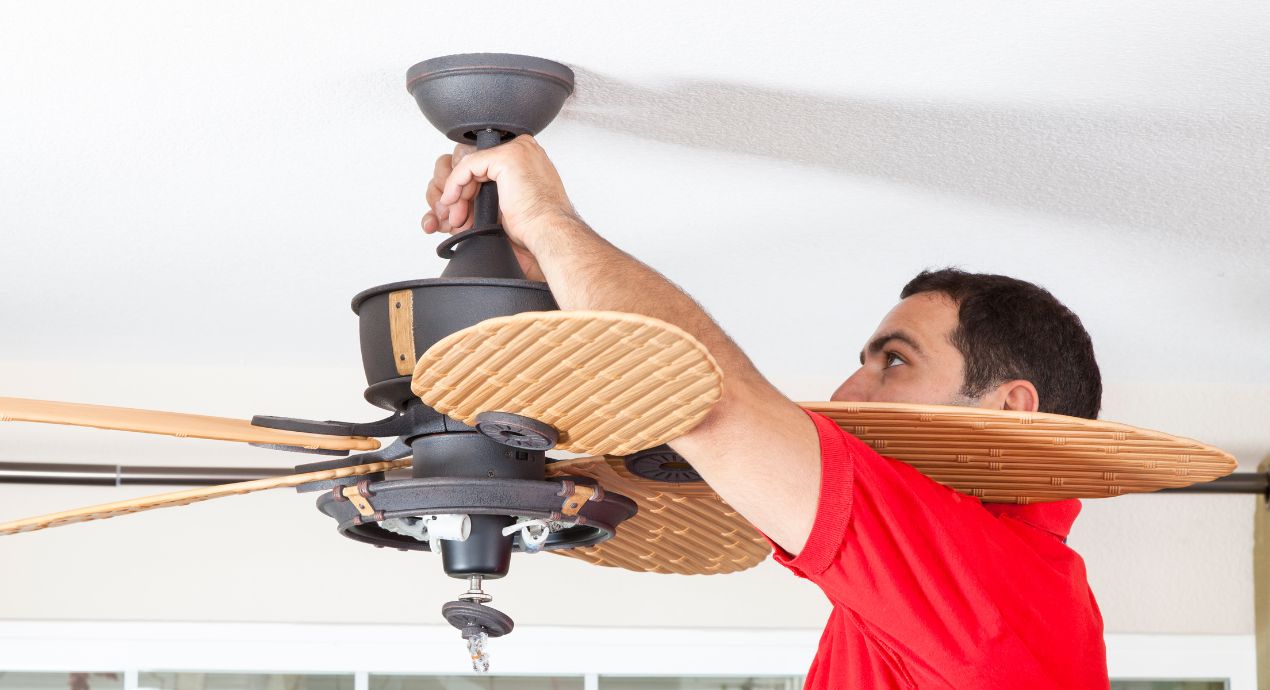
Contemplating coverage?
Subscribe to receive our emails & get
$200 off!
Have questions?
Call us: (833) 544-8273


Written By Clint Bird
Most people think of a ceiling fan as a useful tool for cooling down a room on a moderately warm day, but a ceiling fan can also serve to make a room feel warmer when the weather turns chilly. If you change the spin direction of your ceiling fan, winter days and nights will feel a little more comfortable—and you’ll save some money on heating costs in the process.
In this article, we’ll explain the science behind using a ceiling fan to make a room feel warmer. We’ll also review how to change the spin direction of ceiling fans.
Unlike air conditioners and heaters, ceiling fans cannot change the temperature of a room. They can, however, make a room feel cooler or warmer. Ceiling fans can achieve this effect by displacing warmer or cooler pockets of air.
The air in any given space is not usually a uniform temperature. Warmer air rises toward the ceiling, and cooler air settles above the floor. When the pitched blades of a ceiling fan spin counterclockwise, the air under the fan is pushed down in an invisible column. As the draft reaches the floor, that displaced air spreads across the floor before moving up the sides of the room. It eventually returns to the ceiling and is again forced downward. This cycle continues to repeat as long as the fan is turned on.
In the summer months, this circulation relieves us of warm, stuffy air and allows us to feel some of the cooler air in the room. The movement of air also facilitates evaporative cooling on the surface of our skin, making us feel cooler.
Even though ceiling fans do not change the ambient temperature of a room, the cooling sensation is significant. The U.S. Department of Energy (DOE) estimates that a homeowner can raise the thermostat by about 4°F in a room with a ceiling fan and still experience the same amount of climatic comfort.
But how can a ceiling fan make a room feel warmer? If a ceiling fan’s direction is reversed to spin clockwise, it draws air up from the floor. This cooler air blooms across the ceiling and flows down the walls. This action eliminates cool pockets of air and more evenly distributes warmth from the room’s heat source, whether that be a central heating register, baseboard heater, radiator, or space heater.
The default direction for most ceiling fans is counterclockwise, which is the ideal direction of the fan spin for summer. Maintain a counterclockwise spin for as long as the weather stays warm. You should reverse the ceiling fan’s direction so that it spins clockwise in the winter.
To keep things simple, set your fan to spin clockwise when you first turn on your home’s heat for the season. Revert the direction to counterclockwise when you first notice your home feeling warm or stuffy in late spring.
A ceiling fan’s reverse switch may appear in a few places:
Do all ceiling fans reverse? Not quite. Virtually all modern ceiling fans have directional controls, but some models may be unidirectional. This is more likely the case with old ceiling fans—that is, fans manufactured before 1980 or so—and exceptionally low-cost fans.
If you do happen to have a ceiling fan that does not have a directional control, you may be able to simulate the effect of clockwise spinning by changing the pitch of the blades. Fan blades are usually set at an angle of 12 to 14 degrees. If the blades are set to a lesser angle, the fan will slice the air and fail to provide adequate circulation. An angle greater than 14 degrees can create a situation in which the fan encounters too much air resistance, straining the motor and shortening the fixture’s lifespan.
If your fan’s blades are adjustable, simply pitch them in the other direction at the same angle. Even when the fan continues to spin counterclockwise, the inversely angled blades will draw air up from the floor instead of pushing it down.
Used appropriately, ceiling fans can save homeowners a remarkable amount of money. These energy efficient appliances can supplement summer air conditioning and winter heating to reduce overall fuel consumption by up to 15%.
It literally pays to keep your ceiling fans in good condition. One of the most efficient ways of doing this is to subscribe to home warranty coverage. Ceiling fan coverage is included in Liberty Home Guard’s flagship Appliance Guard and Total Home Guard plans. If your ceiling fan’s motor, switch, controls, or bearings fail, we’ll cover the repair and replacement costs. We maintain a network of partnered technicians across the United States, and we can have a qualified professional at your home within 24 to 48 hours of you submitting a claim. For a more detailed explanation of our coverage, call (866)-432-1283.
Stay Ahead of Potential
Home Mishaps!
Subscribe to our Liberty Home Guard Newsletter and gain access to exclusive content that ensures your peace of mind.